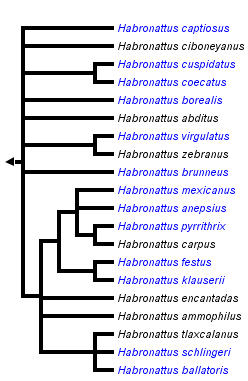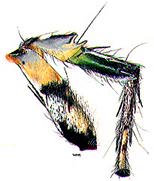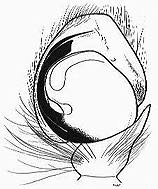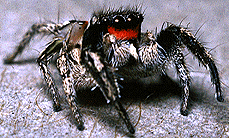Habronattus coecatus group
Wayne Maddison


This tree diagram shows the relationships between several groups of organisms.
The root of the current tree connects the organisms featured in this tree to their containing group and the rest of the Tree of Life. The basal branching point in the tree represents the ancestor of the other groups in the tree. This ancestor diversified over time into several descendent subgroups, which are represented as internal nodes and terminal taxa to the right.

You can click on the root to travel down the Tree of Life all the way to the root of all Life, and you can click on the names of descendent subgroups to travel up the Tree of Life all the way to individual species.
For more information on ToL tree formatting, please see Interpreting the Tree or Classification. To learn more about phylogenetic trees, please visit our Phylogenetic Biology pages.
close boxIntroduction
The H. coecatus group is one of the groups with laterally fringed first legs and modified third legs. The courtship behavior is among the most complex in the genus.
Characteristics



The coecatus group shares with the viridipes group a fringed first leg with spatulate spines and a modified third leg. © Wayne Maddison.

The coecatus group, however, is distinguished by its secondarily straightened tegular apophysis which therefore lacks the characteristic elbow of Habronattus. © Wayne Maddison.
References
Griswold, C. E. 1987. A revision of the jumping spider genus Habronattus F.O.P.-Cambridge (Araneae; Salticidae), with phenetic and cladistic analyses. University of California Publications, Entomology 107: 1-344.
Title Illustrations

| Scientific Name | Habronattus coecatus |
|---|---|
| Location | Lake Corpus Christi, TX |
| Sex | Male |
| Copyright |
© 1994-1995 Wayne Maddison

|
About This Page
Wayne Maddison

University of British Columbia, Vancouver, British Columbia, Canada
Correspondence regarding this page should be directed to Wayne Maddison at
Page copyright © 1995 Wayne Maddison
All Rights Reserved.
Citing this page:
Maddison, Wayne. 1995. Habronattus coecatus group. Version 01 January 1995 (under construction). http://tolweb.org/Habronattus_coecatus_group/4001/1995.01.01 in The Tree of Life Web Project, http://tolweb.org/







 Go to quick links
Go to quick search
Go to navigation for this section of the ToL site
Go to detailed links for the ToL site
Go to quick links
Go to quick search
Go to navigation for this section of the ToL site
Go to detailed links for the ToL site